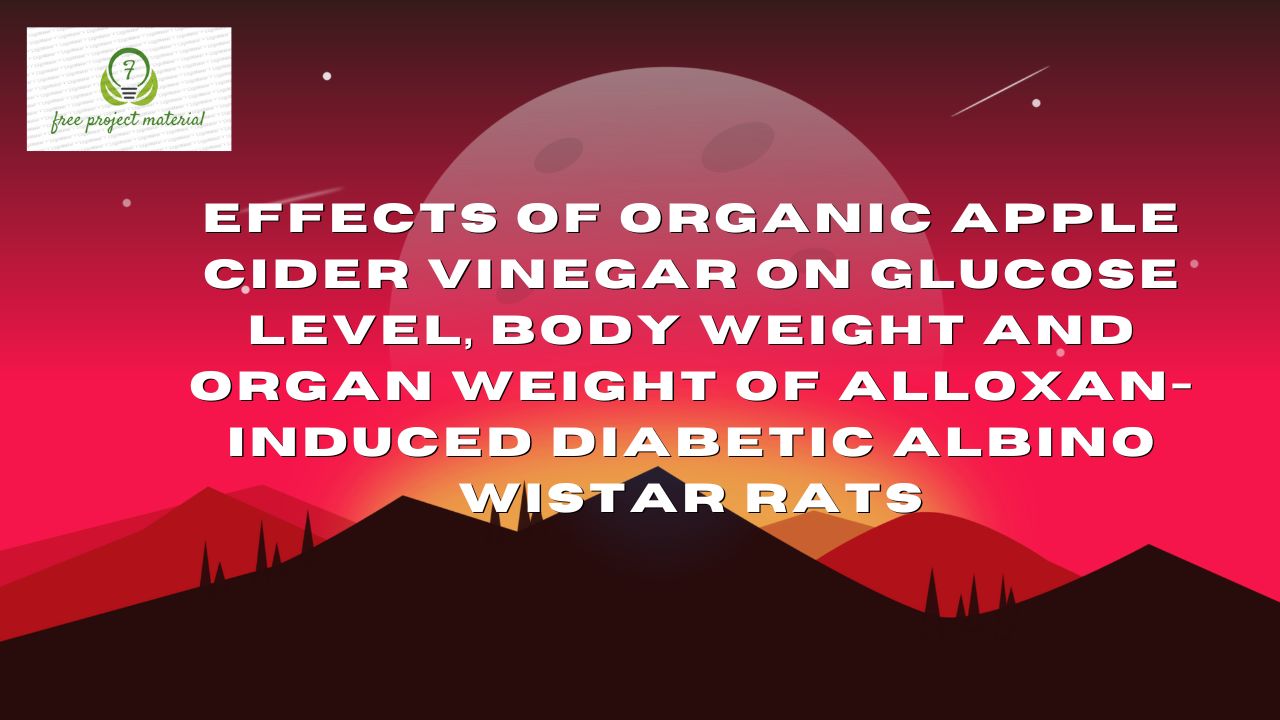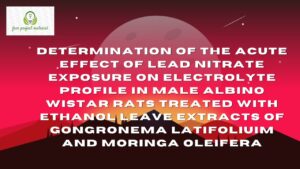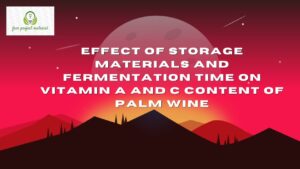ABSTRACT
The study was designed to investigate the effect of organic apple cider vinegar on blood glucose levels, body weight and organ weight of alloxan-induced diabetic Albino Wistar rats. Twenty-five (25) albino wistar rats with the body weight between 74-352g were randomly assigned to 5 groups. Group 1 which served as the control group was administered commercial rat chow and distilled water only, Group 2 which served as the negative control and administered 150mg/kg body weight of alloxan, the experimental groups were sustained on commercial rat chow, distilled water, 0.5ml/kg body weight, 1ml/kg body and 1.5ml/kg body weight of 10% organic apple cider vinegar to every other day for 21 days. All the animals were allow free access to feeds and water ad libitum. The glucose levels and body weight of the animals were taken weekly using a fine-test Glucometer machine and weighing balance. The result showed that mean glucose concentration in Groups 2 and 4 had a non-significant increase (P>0.05), Group 3 non-significantly decrease (P<0.05) and Group 5 significantly decrease on the final day when compared to the initial day. The mean body weight was significantly increased (P<0.05) in all the groups, except for Group 4 which showed a significant decrease on the final day when compared to the initial day. The mean organ weight of the kidney showed a significant increase (P<0.05) in all the groups, except Group 3 which non-significantly increased (P>0.05) when compared to the control. The mean weight of the pancreas showed a non-significant increase (P>0.05) in all the groups, except for Group 5 which had a significant increase (P<0.05) when compared to the control. The mean liver weight showed a non-significant decrease (P>0.05) in all the groups, except in Group 3 which non-significantly increased (P>0.05) when compared to the control. This result suggest that the organic apple cider vinegar could be used as a possible Antidiabetic therapy and also could be used in weight loss but caution must be employed when administering the organic extract at much higher doses.
TABLE OF CONTENTS
TITLE PAGE- – – – – – – – i
CERTIFICATION- – – – – – – ii
DEDICATION- – – – – – – – iii
ACKNOWLEDGMENT- – – – – – iv
ABSTRACT- – – – – – – – v
TABLE OF CONTENTS- – – – – – vi
LIST OF TABLES- – – – – – – vii
CHAPTER ONE: INTRODUCTION
1.1 Background of the Study- – – – – – 1
1.2 Aim and Objectives of the Study- – – – – 7
1.2.1 Aim of the study- – – – – – – – 7
1.2.2 Objectives of the study- – – – – – – 7
1.3 Scope and Limitations- – – – – – – 8
1.4 Significance of the Study- – – – – – 8
CHAPTER TWO: LITERATURE REVIEW
2.1 Description of Apple Cider Vinegar- – – – – 9
2.1.1 Nutritional Value of Apple Cider Vinegar- – – – 11
2.1.2 Safety Concerns of Apple Cider Vinegar- – – – 12
2.1.3 Health Benefits of Apple Cider Vinegar- – – – 13
2.2 Pharmacological Effect of Apple Cider Vinegar- – – 14
2.2.1 Antidiabetic Effect- – – – – – – 14
2.2.2 Weight Control- – – – – – – – 17
2.3 Mechanism of Acton of Apple Cider Vinegar on
Glucose Metabolism- – – – – – – 18
2.4 Global Estimation of Diabetes- – – – – – 19
2.5 Blood Glucose Level- – – – – – – 21
2.6 Body Weight- – – – – – – – 26
2.7 Organ Weight- – – – – – – – 29
2.7.1 Kidney- – – – – – – – – 29
2.7.2 Pancreas- – – – – – – – – 30
2.7.3 Liver- – – – – – – – – – 31
2.8 Alloxan and its Biological Effect- – – – – 33
2.8.1 Mechanism of Action of Alloxan- – – – – 35
2.8.2 The Structure of Alloxan- – – – – – – 38
CHAPTER THREE: MATERIALS AND METHODS
3.1 Materials- – – – – – – – – 39
3.2 Methods- – – – – – – – – 39
3.2.1 Sample Collection- – – – – – – 39
3.2.2 Preparation of Sample- – – – – – – 40
3.2.3 Experimental Animal- – – – – – – 40
3.2.4 Experimental Design and Grouping of Animals- – – 41
3.3 Determination of Blood Glucose Level- – – – 42
3.3.1 Determination of Body Weight of the Rats- – – – 43
3.3.2 Determination of Organ Weight of the Rats- – – – 43
3.4 Statistical Analysis- – – – – – – 43
CHAPTER FOUR: RESULTS AND DISCUSSION
4.1 Results- – – – – – – – – 44
4.2 Discussion- – – – – – – – – 48
CHAPTER FIVE: RECOMMENDATION AND CONCLUSION
5.1 Conclusion- – – – – – – – – 55
5.2 Recommendations- – – – – – – 55
REFERENCES
CHAPTER ONE: INTRODUCTION
1.1 Background of the Study
Apple cider vinegar is an acidic solution produced by fermenting apples. It contains vitamins, minerals and many trace elements (Banna and Kawar, 2002). It contains a potent supply of potassium. Potassium is essential for soft tissue repair and the replacement of worn-out tissues within the body. Cider vinegar improves the health and function of the vital organs of the body by preventing excessively alkaline urine. It is a strong detoxifying and purifying agent. It breaks down fatty, mucous and phlegm deposits within the body. It also oxidizes and thins the blood, which is important in preventing high blood pressure. Cider vinegar has been found to neutralize any toxic substances that enter the body. It neutralizes harmful bacteria that may be found in certain foods, promotes digestion, assimilation and elimination (Vijakumar and Wolf-Hall, 2002)
Toxic build-ups with the body can cause boils, blisters, acne, etc. Cider vinegar detoxifies and helps with the cleansing and clotting processes of the blood, by helping along the blood oxidation process. When a mixture of cider vinegar and water is taken before a meal (particularly food served in restaurants or at picnics where the preparation or duration of food left uncovered and not refrigerated is questionable), it seems to prevent diarrhea or digestive upsets (Ryu and Bjornsdottir, 2006). Cider vinegar can be taken alone or used in cooking. The best method of using apple cider vinegar is in its natural liquid form.
Cider vinegar is thought to be beneficial in the treatment of arthritis, asthma, nose bleeds, osteoporosis, cancer, Candida, high cholesterol, colds, constipation, muscle cramps, colitis, diabetes, diarrhea, depression, dizziness, ear discharge, eczema, fatigue, gallstones, kidney stones, hay fever, headaches, heartburn, hiccups, indigestion, insomnia, kidney and bladder problems, metabolism, nasal congestion, sore throats, stiff joints, ulcers and weight loss. Some reports showed that vinegar effect the glucose and insulin responses to a sucrose or starch load. It is near 25 years that several in vivo and in vitro studies have analyzed the effect of vinegar on glucose metabolism in healthy subjects and in subjects with diabetes mellitus.
One of the major worldwide health problems is diabetes. Diabetes appears to be increasing in most countries, due to increasing population growth, aging, urbanization, and increasing prevalence of obesity and physical inactivity. Diabetes is a metabolic disease which affects not only the glucose metabolism but also lipid and protein metabolism. Diabetes can lead to increased cardiovascular mortality, nephropathy, neuropathy and retinopathy. There are mainly two types of diabetes–Type 1 and Type 2. In Type 1 diabetes, the hormone insulin is not produced while Type 2 diabetes mellitus (T2DM) is characterized by a relative decreased sensitivity of target tissues to the action of this hormone and progressive impairment of insulin secretion. Approximately one T2DM patients are treated with oral hypoglycemic agents to stimulate insulin secretion (Wild et al., 2004; Hannan et al., 2003).
T2DM is managed through a program that consists of lifestyle modifications including appropriate diet and exercise programs and addition of oral antihyperglycemic agent. Although oral hypoglycemic agents (insulin) are the mainstay of treatment of diabetes and are effective in controlling hyperglycemia, they have prominent side effects and fail to significantly alter the course of diabetic complications. The common side effects associated with the main classes of drugs used for the treatment of T2DM are hypoglycemia, weight gain, gastrointestinal disorders, peripheral edema and liver disease (Esposito et al., 2008).
According to recent estimates, diabetes mellitus is a growing problem. Over 171 million people were living with diabetes worldwide in the year 2000, and the estimated number is to increase to 366 million by 2030 (Wild et al., 2004). Diabetes mellitus has been defined as a chronic disease with persistently elevated blood glucose concentration. It is a major and growing public health problem throughout the world.
In modern medicine no satisfactory effective therapy is still available to cure diabetes mellitus, which is a syndrome resulting from a variable interaction of hereditary and environmental factors and characterized by abnormal insulin secretion or insulin receptor or post-receptor events affecting metabolism involving carbohydrates, proteins and fats in addition to damaging β-cells of pancreas, liver and kidney in some cases. Management of diabetic patients depends on the dietary and lifestyle factors where they play an important role not only in the etiology but also in the control of the disease and its complication (Xuemei et al., 2012).
Liver disease is one of the dealing causes of death in persons with type 2 diabetes. The standardized mortality rate death from liver disease is greater than that cardiovascular disease. The spectrum of liver disease in type 2 diabetes ranges from non-alcoholic fatty liver disease to cirrhosis and hepatocellular carcinoma. Experimental type 1 diabetes induced with streptozotocin or alloxan in rats displays many features seen in human subjects with uncontrolled diabetes mellitus.
Many studies have shown an association between specific diabetic complications and disturbances in various tissues such as diabetic nephropathy and peripheral neuropathy, but only limited data is available on the possible association between diabetic complication and liver function (Arkkila et al., 2001).
One of the most potent methods to induce experimental diabetes mellitus is chemical induce experimental diabetes mellitus is chemical induction by Alloxan (Etuk, 2010). It is a well-known diabetogenic agent that is used to induce type 1 diabetes in experimental animals. Alloxan is a urea derivative which causes selective necrosis of the β-cell of pancreatic islets. In addition, it has been widely used to produce experimental diabetes in animals such as rabbits, rat, mice and dogs with different grades of disease severity by varying the dose of alloxan used (Etuk, 2010; Iranwye et al., 2011).
As it has been widely accepted that alloxan selectively destroys the insulin-producing beta-cells found in the pancreas, hence it is used to induce diabetes in laboratory animals. The toxic action of alloxan on pancreatic betacells involve oxidation of essential suphydryl (-SH group), inhibition of glucokinase enzyme, generation of free radicals and disturbances in intracellular calcium homeostasis. The underlying mechanism involves the selective uptake of the compound due to its structural similarity to glucose as well as highly efficient uptake mechanism of the pancreatic beta-cells (Lenzen, 2008; Viswanathaswamy et al., 2011).
1.2 Aim and Objectives of the Study
1.2.1 Aim of the study
The aim of this research project is to determine the effect of organic extract of Apple cider vinegar on glucose level, body weight, and organ weight of Albino wistar rats induced with Alloxan.
1.2.2 Objectives of the study
The objective of the research project is to determine;
- The effect of administration of organic extract of Apple cider vinegar on the glucose level of alloxan-induced diabetic Albino wistar rat.
- The effect of administration of organic extract of apple cider vinegar on body weight of alloxan-induced diabetic Albino wistar rat.
- The effect of administration of organic extract of apple cider vinegar on organ weight (kidney, pancreas and liver) of alloxan induced diabetic Albino wistar rat.
1.3 Scope and Limitations
This research work is limited to the investigation of the effect of co-administration of organic extract of Apple cider vinegar on the glucose level, body weight and organ weight (Kidney, pancreas and liver) of alloxan-induced diabetic Albino wistar rat. The scope is limited by time as well as financial constraints.
1.4 Significance of the Study
The significance of the study lies in it’s potential to provide valuable insight into the potential therapeutic benefits of Apple cider vinegar in the management of diabetes. Understanding the effect of Apple cider vinegar on glucose level, body weight and organ weight in diabetic rats shed light on it potential hepatoprotective properties and its impact on glucose level in the context of diabetes.



